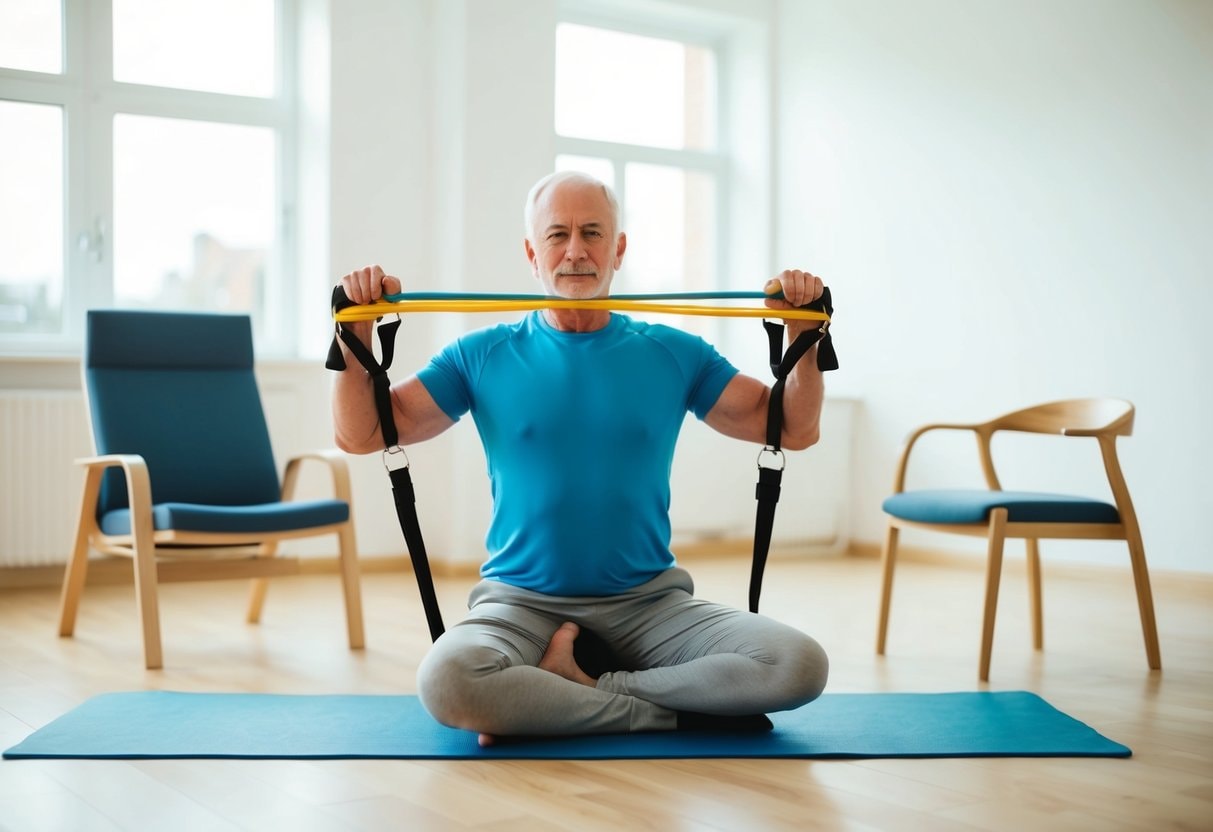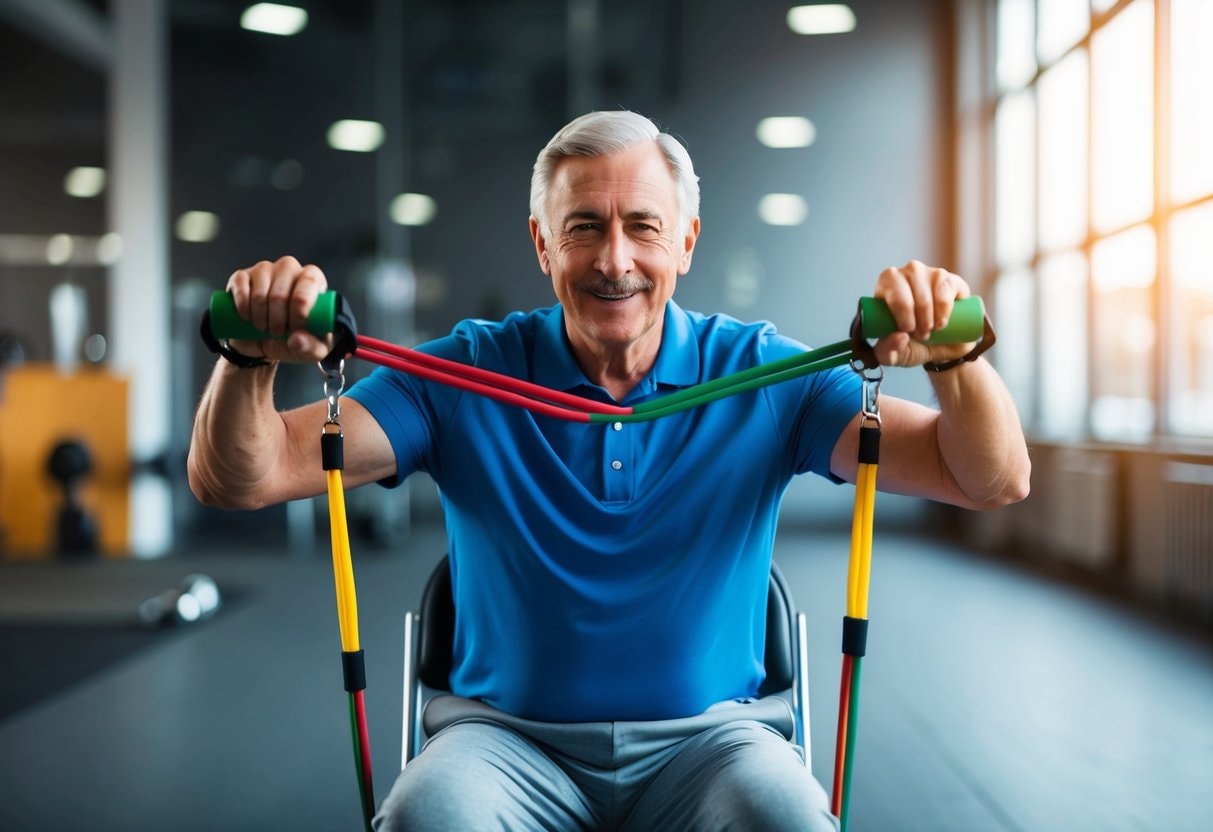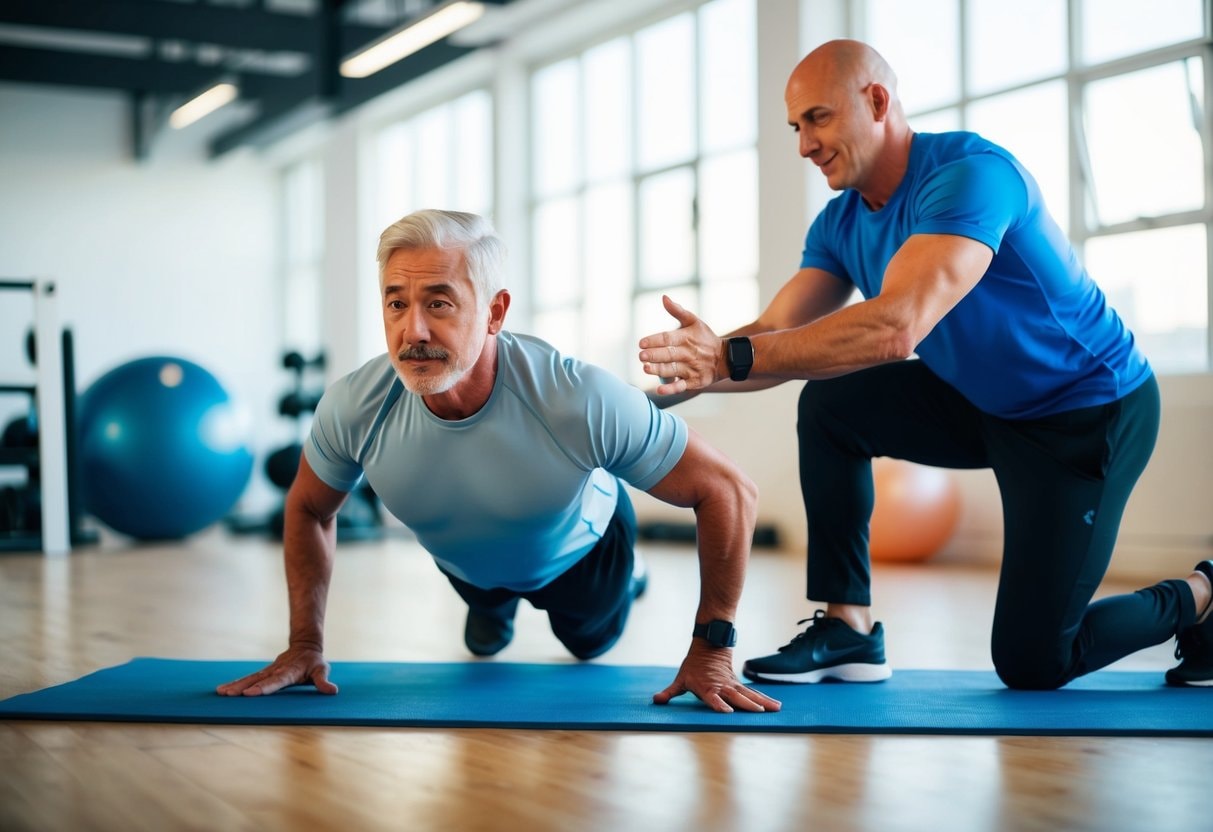Isometric exercises for seniors offer a low-impact, effective way to build strength without straining the joints. These isometric exercises for seniors focus on muscle contraction without heavy lifting, making them ideal for older adults looking to enhance stability and improve overall fitness. By incorporating isometric exercises into a routine, seniors can enjoy improved muscle endurance, better posture, and greater control over their movements while reducing the risk of injury. Discover how this simple yet powerful strength training can contribute to a healthier, more active lifestyle.
Isometric Exercises for Seniors: A Beginner’s Guide to Gentle Strength Training

As we get older, staying active becomes more important than ever. Isometric exercises offer a gentle yet effective way for seniors to keep fit. These exercises don’t require fancy equipment or gym memberships, making them perfect for at-home workouts. Isometric exercises can help seniors build strength, improve balance, and boost flexibility without putting stress on joints.
You simply hold a position for a set time, engaging your muscles without moving. This makes them safe and easy for most people to try. Starting an isometric exercise routine is simple. You can begin with basic moves like wall sits or planks. You can add more challenging exercises to your routine as you get stronger. The best part? You can do these exercises anytime, anywhere.
Key Takeaways
- Isometric exercises are safe and effective for seniors to build strength and improve mobility.
- You can do isometric exercises at home without special equipment.
- Start with simple exercises and gradually increase difficulty as you get stronger.
The Benefits of Isometric Exercises for Seniors
Isometric exercises offer many advantages for older adults. They can help you stay strong, steady, and flexible without putting too much stress on your body.
Improved Muscle Strength
Isometric exercises can help maintain and increase your muscle strength. These exercises work by holding a position without moving. This type of workout is great for building strength in specific muscles. You can do isometric exercises almost anywhere. They don’t need special equipment. This makes them perfect for seniors who cannot go to a gym. Regular practice can help you keep your muscles strong as you age. Strong muscles are key for daily tasks like carrying groceries or climbing stairs.
Enhanced Balance and Stability
Isometric exercises can boost your balance and stability. Many of these exercises work your core muscles. A strong core helps you stay steady on your feet. Better balance means less risk of falls. This is very important for seniors. Falls can lead to serious injuries. Isometric exercises that engage your core can improve your stability. Try exercises like wall sits or planks. These can help you feel more secure when walking or standing.
Increased Joint Flexibility
Isometric exercises can help keep your joints flexible. They put less stress on your joints than other types of exercise. This makes them great for seniors with joint problems. You can do isometric exercises for different parts of your body. For example, you can work on your shoulders, hips, or knees. This helps keep all your joints moving well. Flexible joints mean you can move more easily. This can make daily tasks simpler and more comfortable.
Pain Management and Reduction
Isometric exercises can help manage and reduce pain, especially for seniors with arthritis or joint pain. These exercises don’t involve moving your joints through their full range of motion. This means less stress on sore spots. Regular practice can strengthen the muscles around your joints. This extra support can help ease pain over time. Isometric exercises can also improve blood flow to your muscles. This can help reduce stiffness and soreness. Many seniors find they feel better overall with a regular isometric exercise routine.
Did you Know?
Did you know that many helpful resources are available to learn more about isometric exercises for seniors? You can check out books on isometric training for in-depth guides and workout plans, providing a solid foundation to start your exercise journey.
Understanding Isometric Exercises

Isometric exercises for seniors are a great way to build strength without moving your joints. These exercises are easy on the body and can help seniors get stronger.
Defining Isometric Exercise
Isometric exercises involve holding a position without moving. Your muscles work hard, but they don’t change length. This type of exercise is safe and effective for seniors. Some examples of isometric exercises are:
- Wall sits.
- Planks.
- Holding a push-up position.
These exercises make your muscles work against a fixed object or your body weight. You don’t need any special equipment for many isometric exercises.
How Isometrics Differ from Other Exercises
Isometric exercises are different from other types of workouts. In regular exercises, you move your muscles through a range of motion. But in isometrics, you hold still. Here’s how isometrics compare to other exercises:
- They put less stress on your joints.
- You can do them anywhere.
- They’re good for building core strength.
Isometrics help improve your muscle endurance. This means you can hold positions longer over time. They’re also great for people who can’t do high-impact exercises.
Getting Started with Isometric Training

Isometric exercises are great for seniors to build strength safely. You can do them at home without special equipment. Before starting, take some key safety steps and talk to your doctor.
Safety Tips for Seniors
Start slow with isometric training. Hold each position for 5-10 seconds at first. You can do these exercises while watching TV or relaxing at home. Don’t hold your breath during the exercises. Keep breathing normally. Choose a stable surface for balance. A sturdy chair or wall works well as a support. Wear comfy clothes and shoes with a good grip.
Listen to your body. Stop if you feel pain or dizziness. Feeling some muscle tightness is normal, but sharp pain isn’t good. Take breaks between exercises. Drink water to stay hydrated. Start with 2-3 exercises and slowly add more as you get stronger.
Consulting with Healthcare Providers
Talk to your doctor before starting isometric training. This is extra important for health issues like high blood pressure or heart problems. Your doctor can tell you which exercises are safe for you. They may suggest changes based on your health needs.
A physical therapist can teach you the right form. They’ll make sure you’re doing the moves safely. Ask them to show you some beginner-friendly isometric exercises. Keep your doctor updated on your progress. Let them know if you have any pain or problems. They can help adjust your routine as needed.
Basic Isometric Exercises for Beginners

Let’s explore some simple isometric exercises for seniors that you can do at home. These isometric exercises for seniors are great for building strength without putting too much strain on your joints.
Isometric Hand Exercises
Start with hand exercises to improve grip strength. Grab a small ball or rolled-up towel. Squeeze it as hard as you can for 5-10 seconds. Relax and repeat 5-10 times. Try another hand exercise. Place your palms together in front of your chest.
Push them against each other for 5-10 seconds. Relax and repeat 5-10 times. For finger strength, spread your fingers wide. Use your other hand to gently push against them. Hold for 5-10 seconds. Switch hands and repeat.
Seated Leg Presses
Sit in a sturdy chair with your feet flat on the floor. Lift one foot slightly off the ground. Push down with that foot as if trying to press the floor. Hold for 10-15 seconds. Release and switch to the other foot. Do this 5-10 times for each leg. For a challenge, try pressing both feet down at once. Imagine you’re trying to push the floor away. Hold for 10-15 seconds, then relax. Repeat 5-10 times.
Isometric Wall Sits
Stand with your back against a wall. Slowly slide down until your knees are bent at about a 90-degree angle. Your thighs should be parallel to the floor. Hold this position for 10-30 seconds, depending on your strength. Stand back up and rest for a minute. Repeat 3-5 times. As you get stronger, try to hold the position longer. Aim for up to 60 seconds per hold.
Armchair Isometric Exercises
Sit in a sturdy armchair. Grip the arms of the chair and try to lift yourself slightly. Hold for 5-10 seconds, then relax. Repeat 5-10 times. For an arm workout, push down on the arms of the chair. Imagine you’re trying to push them onto the floor. Hold for 10 seconds, then relax. Do this 5-10 times. Try an ab exercise. Sit up straight and tighten your stomach muscles. Hold for 10 seconds, then relax. Repeat ten times.
Incorporating Isometrics into Daily Life
Adding isometric exercises for seniors to your routine can be easy and fun. You can do them almost anywhere, anytime. These simple moves help you stay strong and steady.
Routine Integration Strategies
Start by adding isometrics to activities you already do. Try wall sits while brushing your teeth. Hold a plank pose during TV commercials. Do calf raises while waiting in line at the store. Make your chores count. When folding laundry, pause to squeeze a pillow between your hands for 10 seconds. While washing dishes, do counter push-ups. Use everyday objects as tools. Hold a book against the wall with your palm for arm strength. Squeeze a tennis ball for hand exercises.
Short, Frequent Exercise Sessions
Keep your isometric workouts brief but regular. Aim for 3-5 short sessions throughout your day. Each session can be just 5-10 minutes long. Start your morning with gentle leg extensions while sitting in bed. Do seated shoulder presses during lunch. End your day with standing quad contractions. Set reminders on your phone or watch.
This helps you remember to do your exercises. Try different moves each time to work on various muscle groups. Remember to breathe normally during each hold. Count slowly to 10 or 15 for each exercise. Rest for a few seconds between holds.
Progressing with Isometric Exercises

As you get stronger, you’ll want to make your isometric exercises for seniors more challenging. This will help you keep improving and reaching new fitness goals.
Recording Progress and Goal Setting
Start by keeping a workout log. Write down which exercises you do and how long you hold each position. This will help you see your progress over time. Set small, achievable goals for yourself. You may want to hold a wall sit for 10 seconds longer next week. Or you could aim to do one more rep of an exercise.
Celebrate your wins, no matter how small. Did you exercise three times this week instead of two? That’s great! Recognizing your progress will keep you motivated. Consider using a fitness app to track your workouts. Many apps let you log exercises, set goals, and see your progress in charts or graphs.
Increasing Exercise Difficulty Safely
As you get stronger, you can make your exercises harder. But always do this slowly and carefully. Try holding positions for longer. If you usually hold a plank for 15 seconds, aim for 20 seconds next time. Increase by small amounts to avoid strain. Add more reps to your routine. Instead of doing each exercise once, try it twice or thrice. This builds strength and endurance.
Use resistance bands to add challenge. These stretchy bands can make many isometric exercises harder. Start with light resistance and work your way up. Change your body position slightly. For a wall sit, move your feet farther from the wall. This makes the exercise tougher on your legs. Remember, safety comes first. If an exercise feels too hard, go back to an easier version. It’s okay to take it slow. Your body will thank you!
Here’s another video on isometric exercises for seniors.
By: 10-Minute Fitness
Embracing Strength: The Lasting Benefits of Isometric Exercises for Seniors
In conclusion, isometric exercises for seniors are an excellent way to enhance strength, stability, and flexibility while minimizing the risk of injury. This gentle form of strength training allows older adults to engage their muscles without needing movement or heavy lifting, making it an accessible and effective option for maintaining fitness. By incorporating these exercises into a routine, seniors can enjoy various benefits, from improved muscle endurance and balance to enhanced joint flexibility and pain management.
Starting with simple isometric exercises and gradually increasing their difficulty can empower seniors to take charge of their health and well-being. Whether performed at home or integrated into daily activities, these exercises offer a convenient and safe way to stay active. Embrace the power of isometric training and discover how it can lead to a healthier, more active lifestyle in the golden years.
Frequently Asked Questions
What Are Some Simple Isometric Exercises for Seniors Just Starting?
Wall sits are great for beginners. Stand with your back against a wall and slowly slide down until your knees are bent at 90 degrees. Hold this position for 10-30 seconds. Another easy exercise is the plank hold. Get into a push-up position, but rest on your forearms instead of your hands. Keep your body straight and hold for 10-30 seconds.
Which Isometric Exercises Target the Upper Body for Older Adults?
The wall push is an effective upper-body exercise. Stand facing a wall and place your palms against it at shoulder height. Lean in slightly and hold the position. You can also try isometric bicep curls. Hold a lightweight in each hand with your elbows at your sides. Bend your elbows to 90 degrees and hold.
How Long Should a Senior Hold an Isometric Exercise for Maximum Benefit?
Start with 10-15 second holds and gradually work up to 30-60 seconds. Do 2-3 sets of each exercise. Remember to breathe normally during the hold. Take short breaks between sets. Listen to your body and stop if you feel pain or discomfort.
Recharge Your Fitness Journey After 55!
Hello, fitness enthusiasts! Uncover the keys to vitality and wellness with Fit After 55! Whether you’re a fitness veteran or just beginning, our platform is your ultimate guide to holistic health. From setting achievable goals to celebrating milestones, we’re here to help you redefine what thriving after 55 truly means. Join our website and facebook page today and unlock your full potential with Fit After 55!
